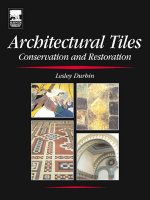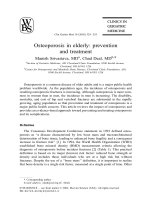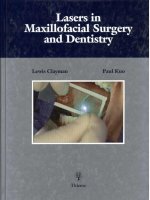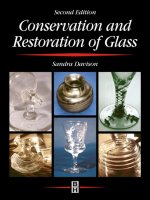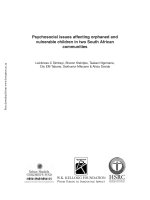Electrochemical Methods in Archaeometry, Conservation and Restoration potx
Bạn đang xem bản rút gọn của tài liệu. Xem và tải ngay bản đầy đủ của tài liệu tại đây (13.38 MB, 177 trang )
Electrochemical Methods in Archaeometry,
Conservation and Restoration
Monographs in Electrochemistry
Surprisingly, a large number of important topics in electrochemistry is not covered by
up-to-date monographs and series on the market, some topics are even not covered
at all. The series Monographs in Electrochemistry fills this gap by publishing in-
depth monographs written by experienced and distinguished electrochemists, cover-
ing both theory and applications. The focus is set on existing as well as emerging
methods for researchers, engineers, and practitioners active in the many and often
interdisciplinary fields, where electrochemistry plays a key role. These fields will
range – among others – from analytical and environmental sciences to sensors,
materials sciences and biochemical research.
Information about published and forthcoming volumes is available at
/>Series Editor: Fritz Scholz, University of Greifswald, Germany
Antonio Dom
´
enech-Carb
´
o
Mar
´
ıa Teresa Dom
´
enech-Carb
´
o
Virginia Costa
Electrochemical Methods
in Archaeometry,
Conservation and Restoration
123
Dr. Antonio Dom
´
enech-Carb
´
o
Universitat Val
`
encia
Fac. Qu
´
ımica
Depto. Qu
´
ımica Anal
´
ıtica
C/Dr. Moliner, 50
46100 Burjasot Valencia
Spain
Prof. Dr. Virginia Costa
15 rue Jules Hetzel
92190 Meudon
France
Prof. Dr. Mar
´
ıa Teresa Dom
´
enech-Carb
´
o
Universitat Polit
`
ecnica de Val
`
encia
Inst. Restauraci
´
o del Patrimoni
Depto. Conservaci
´
oi
Restauraci
´
o de Bens Culturals
Cam
´
ı de Vera, s/n
46022 Val
`
encia
Spain
ISBN 978-3-540-92867-6 e-ISBN 978-3-540-92868-3
DOI 10.1007/978-3-540-92868-3
Library of Congress Control Number: 2008942070
c
Springer-Verlag Berlin Heidelberg 2009
This work is subject to copyright. All rights are reserved, whether the whole or part of the material is
concerned, specifically the rights of translation, reprinting, reuse of illustrations, recitation, broadcasting,
reproduction on microfilm or in any other way, and storage in data banks. Duplication of this publication
or parts thereof is permitted only under the provisions of the German Copyright Law of September 9,
1965, in its current version, and permission for use must always be obtained from Springer. Violations are
liable to prosecution under the German Copyright Law.
The use of general descriptive names, registered names, trademarks, etc. in this publication does not imply,
even in the absence of a specific statement, that such names are exempt from the relevant protective laws
and regulations and therefore free for general use.
Cover design: WMXDesign, Heidelberg
Printed on acid-free paper
987654321
springer.com
Preface
Electrochemical systems—e.g., batteries, capacitors, and fuel cells—are an integral
part of modern technology. Electrochemical techniques, especially potentiometry
and voltammetry, are indispensable for state-of-the-art analysis, and also for funda-
mental studies of the properties of solution species and solid phases and materials.
Last, but not least, electrochemical concepts for understanding charge transfer re-
actions entered the fields of biochemistry and biophysics. Indeed, the last century
is characterized by a constant expanding of applications into more and more fields
of science and technology. Among these new applications are also archeometry,
conservation, and restoration. Electrochemistry is well-suited for these destinations
because it can be used to investigate metals and alloys, and it can be used to an-
alyze solid phase systems. Electrochemistry makes thermodynamical and kinetic-
based information accessible on redox systems that are frequently constituents of
archaeological and historic objects. The authors of this monograph are three lead-
ing scientists who are very well-known for their seminal contributions to the use
of electrochemical techniques for analytical characterization of such objects, as
well as for their restoration. The authors are equally well-acquainted with all the
other techniques, be it spectroscopic, diffraction, chromatographic, or microscopic
techniques, etc. This allows them to present an unbiased view on electrochemical
techniques. This monograph is the result of extensive experience with electrochem-
istry, and the analysis and restoration of objects of cultural heritage. Thus, I am
very thankful to siblings Teresa and Antonio Dom
´
enech-Carb
´
o from Spain, and to
Virginia Costa from France for having agreed to co-write this monograph, which
will be beneficial for two rather different communities: a) electrochemists and elec-
troanalysts, who may learn a lot about the fruitful application of their techniques
for the analytical characterization of historic objects, and also for conservation and
restoration, and b) scientists working in laboratories of conservation, restoration,
and analysis of historic objects, who can learn a lot about the high potential of elec-
trochemistry in their work. The fact that the monograph had to be written for these
two scientific communities posed serious problems because normally, the scientists
of these two communities will not know much about each others’ science. I think
that the authors of the monograph have found a very good way to respond to the
v
vi Preface
needs of all readers for understanding this very interdisciplinary topic, and I hope
that the book will be beneficial for the broad audience it addresses.
September 2008 Fritz Scholz
EditoroftheseriesMonographs in Electrochemistry
Contents
1 Application of Instrumental Methods in the Analysis of Historic,
Artistic and Archaeological Objects 1
1.1 Importance of Scientific Examination for Archaeometry,
ConservationandRestoration 1
1.2 InformationProvidedbytheAnalyticalResearch 3
1.2.1 AnalyticalInformationObtainedfromtheObject 3
1.2.2 Analytical Information Obtained from the Environment . . . . 6
1.2.3 Analytical Information Obtained
from the Conservation Process . . . . 7
1.3 Requirements of Analytical Methodology Applied
to Archaeometric and Conservation Research . . 8
1.3.1 SamplingStrategy 8
1.3.2 Preparation of Samples . . . 10
1.3.3 MeasurementofAnalyticalParameters 11
1.3.4 DataProcessing 12
1.4 An Overview on Analytical Methods Applied
in Archaeometry and Conservation of Cultural Goods . . 12
1.4.1 Examination Based on Recording Images:
The Holistic Approach . . . . 13
1.4.2 Analytical Methods: The Reductionist Approach . . . . 15
1.4.3 Point analysis providing chemical composition of layers
andbulk 16
1.4.4 Point analysis providing molecular and crystalline structure . 19
1.4.5 Point Analysis Providing Morphology, Texture
andStrataDistribution 23
1.4.6 Microbeam Analysis Providing Microdomain, Surface
Structure, and Composition . . . . . . . 25
1.4.7 Dating Methods . . 28
1.5 FinalConsiderations 31
2 Identification of Species by Electrochemical Methods 33
2.1 Introduction . 33
2.2 Conventional Voltammetry . . . . . . . 33
vii
viii Contents
2.3 Voltammetry of Microparticles . . . 40
2.4 Identification of Species Involving Electrochemically Depositable
Metals 44
2.5 Identification of Metallic Species . 48
2.6 Identification of Species Using Reductive/Oxidative Dissolution
Process . 49
2.7 Identification of Species Via Solid-State Transformations . . . 51
2.8 AnalyticalStrategies 55
3 Resolution of Multicomponent Systems and Speciation 65
3.1 Introduction . 65
3.2 Analysis of Single Multicomponent Systems . . . 66
3.3 Criteria for Pattern Recognition . . . 68
3.4 Bi-ParametricDataAnalysis 70
3.5 Multivariate Methods 84
3.6 Speciation. . . 87
4 Quantitative Methods 95
4.1 Quantitation . 95
4.2 Phase Composition . . 96
4.3 Relative Quantitation 97
4.4 Absolute Quantitation, Standard Addition Method . . . . . 106
4.5 H-Point Standard Addition Methods . . . . . . 110
5 Electrochemical Basis of Corrosion of Cultural Objects 123
5.1 A Search for Equilibrium . 123
5.2 Degradation Under Particular Conditions . . 125
5.2.1 Archaeological Artifacts . . 125
5.2.2 Monuments . . 129
5.2.3 HistoricArtifacts 131
5.3 SomeUsefulCorrosion 133
6 Electrochemistry in Treatment and Conservation of Metal Artifacts . 135
6.1 Electrochemical Treatment of Metal Artifacts . . 135
6.1.1 HistoricalEvolution 135
6.1.2 Cleaning . . . . 135
6.1.3 Stabilization 136
6.1.4 Consolidation 137
6.1.5 StateoftheArt 137
6.2 EvaluationofMuseumEnvironment 139
Bibliography 141
About the Editor 157
About the Authors 159
Index 161
List of Acronyms
AA: activation analysis
AAS: atomic absorption spectroscopy
AE: acoustic emission
AES: Auger electron spectroscopy
AFM: atomic force microscopy
AMS: accelerator mass spectrometer
ATR: attenuated total reflection
CCD: charge coupled device
CE: capillary electrophoresis
CLSM: confocal laser scanning microscopy
CPE: carbon paste electrodes
CT: computed X-ray tomography
CV: cyclic voltammetry
DC: direct current
DPMS: direct pyrolysis mass spectrometry
DPV: differential pulse voltammetry
DRIFT: diffuse reflection Fourier-transform infrared spectroscopy
DSC: differential scanning calorimetry
DTA: differential thermal analysis
DTMS: direct temperature-resolved mass spectrometry
EDX (EDS): energy dispersive x-ray microanalysis
EELS: electron-energy-loss spectroscopy
ELISA: enzyme-linked immunosorbent assays
EPXMA: electron probe x-ray microanalysis
EPMA: electron probe microanalysis
EPR: electron paramagnetic resonance spectroscopy
ESEM: environmental scanning electron microscopy
ESR: electron spin resonance spectroscopy
FAB-MS: fast-atom bombardment mass spectrometry
FID: flame ionization detector
FLIM: fluorescence lifetime imaging
FTIR: Fourier transform infrared spectroscopy
FTIR-PAS: FTIR photoacoustic spectroscopy
ix
x List of Acronyms
FTO: fluorine-doped tinoxide
GC: gas chromatography
GCE: glassy carbon electrode
GC-MS: gas chromatography- mass spectrometry
HINDT: holographic interferometry nondestructive testing
HPLC: high performance liquid chromatography
IC: ion chromatography
ICP-AES: inductively coupled plasma-atomic emission spectroscopy
ICP-MS: inductively coupled plasma-mass spectrometry
ICP-SMS: inductively coupled plasma sector field mass spectrometry
ICP-TOF-MS: inductively coupled plasma time-of-flight mass spectrometry
IFM: immunofluorescence microscopy
LA-ICPMS: laser ablation inductively coupled plasma-mass spectrometry
LC: liquid chromatography
LDI: laser desorption/ionisation
LDMS: laser induced desorption mass spectrometry
LIBS: laser induced breakdown spectroscopy
LIF: laser-induced fluorescence
LM: light microscopy
LSV: linear potential scan
MALDI: matrix-assisted desorption/ionisation
μ
-SRXRD: micro-x-ray diffraction
μ-XRF: microscopic XRF
μ
-SRXRF:
μ
-XRF spectrometry synchrotron-based
μ
-XANES: micro-x-ray absorption near-edge structure spectroscopy
MC-ICP-MS: multiple collector inductively coupled plasma mass
spectrometry
MRI: magnetic resonance imaging
MS: mass spectrometry
MS-MS: tandem mass spectrometry
NAA: neutron activation analysis
nanoLC-nanoESI-
Q-qTOF-MS-
MS:
nano liquid chromatography- electrospray
ionization-quadrupole time-of-flight tandem
mass spectrometry
NMR: nuclear magnetic resonance
OSL: optically stimulated luminescence
OSP: optically stimulated phosphorescence
PAA: proton activation analysis
PAS: photoacoustic spectroscopy
PC: paper chromatography
PDA: photodiode-array
PFE: polymer film electrode
PIGE: particle-induced gamma-ray emission spectroscopy
PIXE: proton-induced x-ray emission spectroscopy
PTTL: phototransferred thermoluminiscence
List of Acronyms xi
Py-GC-MS: pyrolysis gas chromatography mass spectrometry
Q-ICPMS: quadrupole inductively coupled plasma mass spectrometry
RBS: Rutherford backscattering spectrometry
SAM: scanning Auger microscopy
SCE: saturated calomel (reference) electrode
SEC: size-exclusion chromatography
SEM: scanning electron microscopy
SCLF: single crystal laser fusion
SIMS: Secondary ion mass spectrometry
SIPS: sputter-induced optical spectrometry
SLDV: laser Doppler vibrometry
SPI: speckle pattern interferometry
SPS: speckle pattern shearography
SQWV: square wave voltammetry
STEM: scanning transmission electron microscopy
TEM: transmission electron microscopy
TG: thermogravimetric analysis
TIMS: thermal ionisation mass spetrometry
TL: thermoluminiscence
TLC: thin-layer chromatography
TRM: thermoremanence
XAS:
μ
-x-ray absorption spectroscopy
XPS: x-ray photoelectron spectroscopy
XRD: x-ray diffraction spectrometry
XRF: x-ray fluorescence spectrometry
Introduction
Scientific examination of archaeological pieces and works of art is undoubtedly a
necessary task for archaeometry, conservation and preservation/restoration sciences.
Although essentially focused on metal corrosion problems, electrochemistry was
one of the early applied scientific methodologies in such fields, in both its analyt-
ical and conservative/restorative aspects. Over the last few decades, the scope of
electrochemical methods’ ability to interact with archaeometry, conservation and
restoration has been significantly extended, by virtue of the application of new
approaches—in particular, the voltammetry of microparticles.
The current monograph is devoted to presenting the state of the art with regard to
the intersection between electrochemistry, archaeometry, conservation, and related
scientific fields. The intention in writing this book was to make electrochemical
methods accessible to a reader interested in the study of cultural heritage, but not
necessarily familiarized with electrochemistry. Conversely, this book is also devoted
to electrochemists interested in the possibilities of their scientific branch in the con-
text of studies of cultural goods. In this sense, although the book summarizes the
content of more than 300 publications (listed in the bibliography), the text concen-
trates on branches of electrochemistry directly related with studies on archaeological
pieces and/or works of art.
The book has been structured into roughly three parts. First (Chap. 1), an
overview of analytical methods applied in the study of cultural goods is presented to
situate electrochemical methods in their analytical context. The second part contains
voltammetric methods devoted to the identification (Chap. 2), speciation (Chap. 3),
and quantitation (Chap. 4) of microsample components from works of art and/or
cultural and archaeological pieces. The third part of the book presents selected ex-
amples of the deterioration of metal artifacts, outlining aspects peculiar to the cul-
tural heritage conservation field (Chap. 5), and describes historic and current issues
regarding electrochemical techniques used in restoration treatments and preventive
conservation (Chap. 6).
We would like to express our appreciation and thanks to Fritz Scholz for his accu-
rate and inspired revision of the text, and the support of our colleagues—Francisco
Bosch, Jos
´
e Vicente Gimeno, Sinforiano S
´
anchez, and Rufino Mateo from the Uni-
versity of Valencia; Mar
´
ıa Luisa V
´
azquez, Isabel Mart
´
ınez, and Dolores Julia Yus
´
a
from the Polytechnical University of Valencia; and our collaborators Laura Osete,
xiii
xiv Introduction
Juana De la Cruz, Mar
´
ıa Jos
´
e Casas, Montserrat Moy
´
a, Juan Peris, Julia Ciarrocchi,
Vanja Cialei, Marina Calisti and Vincenzo Maiolo.
Antonio Dom
´
enech-Carb
´
o
Mar
´
ıa Teresa Dom
´
enech-Carb
´
o
Virginia Costa
Chapter 1
Application of Instrumental Methods
in the Analysis of Historic, Artistic
and Archaeological Objects
1.1 Importance of Scientific Examination for Archaeometry,
Conservation and Restoration
Preservation of cultural goods is an important and rewarding task of modern soci-
eties. They are a vital source of inspiration and reflect the culture and history of the
past and present. This valuable asset is the basis for future cultures and therefore,
is one of the main legacies to be passed on to future generations. For this purpose,
conservators, curators, art historians, and scientists combine their efforts, making it
now a pluridisciplinary activity.
Cultural goods are particularly rich and diverse, as they are comprised of a great
variety of materials (and often made from combinations thereof), and they are of
vastly different sizes ranging from archaeological or historical sites, to monuments,
and to objects of fine craft or art. Although their significance stems from the trans-
mitted historical, cultural, or figurative messages, their conservation and perpetu-
ation in time depends on their materials. The Science of Conservation has been
developed for this reason, and is devoted to the scientific study of the objects and
the procedures that assure the safeguarding of cultural goods.
Application of the physical and chemical sciences to tackle the problems and
questions of archaeology, history, and the conservation of heritage dates back
to the 18th century. The first specialized laboratory dedicated to this type of
work was established in 1888: the Chemisches Labor der K
¨
oniglichen Museen zu
Berlin (Chemical Laboratory of the Royal Museums of Berlin, now the Rathgen-
Forschungslabor). This laboratory was set up based on the idea that the scientific
approach to cultural goods is always ancillary to the approach made by the art his-
torian and the conservator. Currently, scientific disciplines play an essential role in
the material characterization of art objects (Scheme 1.1). For example, the dating of
archaeological remains is based on instrumental techniques. Characterization of the
artistic techniques and technologies of production from the analytical data related to
the chemical composition and morphology of the object often allows a clear ascrip-
tion of the studied object to a geographical region, as well as an elucidation of the
date of manufacture. Authentication is sometimes carried out based on analytical
data (i.e., identification of a pigment used in a certain historic period or recognition
A. Dom
´
enech-Carb
´
oetal.,Electrochemical Methods in Archaeometry, Conservation 1
and Restoration, Monographs in Electrochemistry,
DOI 10.1007/978-3-540-92868-3
1,
c
Springer-Verlag Berlin Heidelberg 2009
2 1 Application of Instrumental Methods
Scheme 1.1 Specific issues related to the materials composing the object and its state of preserva-
tion directly derived from analytical data
of a specific artistic technique). Analytical data are essential for determining the
state of conservation of the object, as well as the causes and mechanisms of its de-
terioration. Three principal sources of deterioration are investigated: environmental
factors resulting in mechanical, chemical, or biological alterations; endogen causes
due to incompatibility of materials present in the object; and the ability of the object
to undergo autodegradation or alterations due to old restorations. Scientific exami-
nation of the object provides a complete picture of the type of damage it exhibits:
occurrence of changes in morphology and/or composition, formation of corrosion
products, lixiviation of materials, etc.
Subsequently, based on this fundamental knowledge, it is further helpful to de-
fine, develop, and evaluate conservation concepts, materials, measures, methods,
and techniques of intervention (Scheme 1.2). Analytical control of the intervention
Scheme 1.2 Specific issues related to the conservation and preservation treatments directly derived
from analytical data
1.2 Information Provided by the Analytical Research 3
treatment is essential for assuring that the operations included in the conservation
treatment are performed correctly. Monitoring of the environment is another fun-
damental task for guaranteeing the future conservation of the object under optimal
conditions. Control of temperature, relative humidity, and pollutants in museums
(exhibition and storage rooms), monuments, and buildings of interest, as well as at
archaeological sites, are indispensable activities carried out during the intervention
of the object and beyond. These are good examples of infield applications of ana-
lytical techniques. In parallel, research in the science of conservation is carried out
in the laboratory, which is focused on the development of new, more selective and
sensitive analytical methods, as well as new materials and methods for conservation.
1.2 Information Provided by the Analytical Research
Analytical techniques offer a great deal of information that is relevant to cultural
goods and their preservation conditions. Analytical data provide connections among
causes and effects, and they are the basis for establishing theoretical models that de-
scribe the alteration processes exhibited by the object. In this section, let us consider
the analytical information according to its source: the object, the environment, and
the conservation process.
1.2.1 Analytical Information Obtained from the Object
Analytical data from the object can be grouped as follows:
(a) Morphological information. Technical examination of the object provides in-
formation concerning the size, shape, and method of manufacture, as well as the
presence of damage. The examination of the object can be performed with respect
to the bulk, to a specific part of its surface, or with respect to a microsample prepared
as a thin section or a cross section.
Morphological changes observed in the bulk or on the surface of the object are
associated with the damages inflicted upon the object: debris, dust, superficial de-
posits, crusts, cracks, pores, fissures, fractures, laminations, lixiviations, spots, ef-
florescences, etc. (Figs. 1.1 and 1.2).
Examination of thin sections prepared from microsamples of organic materials
such as wood, parchment, textile, paper, ivory, horn, or leather enables the recog-
nition of anatomical and histological features characteristic of the type of organic
material or botanical specie.
Examination of cross sections (in particular) of samples extracted from poly-
chrome objects provides the complete sequence of pictorial strata present in the ob-
ject, as well as the possible infiltrations or corrosion crusts formed as consequence
of the alteration processes (Fig. 1.3). The distribution of pictorial layers is also es-
sential for establishing the artistic technique used by the artist.
4 1 Application of Instrumental Methods
Fig. 1.1 Cracks and pores formed on the surface of a glazed tile (Manises, 18th century) from the
floor of the balconies of the Bas
´
ılica de la Virgen de los Desamparados de Valencia, Spain
Fig. 1.2 Detail of the bleaching formed on the surface of an oil painting. Examination with stere-
omicroscope denotes the formation of microcrystals on the surface of the paint layer, which are
responsible for the noticeable change of the visual appearance of the painting
1.2 Information Provided by the Analytical Research 5
Fig. 1.3 Cross section of an ancient wall painting illustrating the strata distribution: on the top a
thin translucent protective coating can be recognized, (1); green paint layer, (2); white paint layer,
(3); and thick layer of ground, (4). Underneath all that an original clayey paint layer (5) and its
corresponding ground (6) can be recognized
(b) Physical information. Physical, mechanical, and optical properties of the ob-
ject characterize the material behavior. Consequently, the changes in their original
values indicate that some alteration process took place. Among the properties com-
monly determining the mechanical behavior of the object include density, Young’s
modulus, ultimate tensile strength, ultimate compressive strength, and ultimate flex-
ion strength. Other physical properties that determine the behavior of the solid object
are those related to the porous structure of the material that conforms the object—
namely, saturation coefficient, water vapor conductivity coefficient, water absorp-
tion coefficient, and permeability.
Optical properties such as color, pleochroism, refractive index, and birefringence,
among others, discovered on thin sections when they are examined by means of
a petrographic microscope, are essential for characterizing rocks (sculpture and
architectural materials). They also provide useful information for characterizing pig-
ments, ceramics, glass and glazes, plasters, metals, and slags, as well as for recog-
nizing alteration processes.
(c) Chemical information. A wealth of qualitative and quantitative chemical in-
formation can be obtained from the materials and alteration products formed on the
object. Depending on the analytical technique used, that information can be very di-
verse. Elemental composition is a usual type of data. Structural information can also
be available, including recognition of functional groups or of the complete molecu-
lar structure, mineralogical distribution, degree of crystallinity, and cell parameters.
Presence of isomeric species is frequently detected in organic materials. Electro-
chemical techniques enable identification of electroactive species, and make specia-
tion studies of the examined materials possible. Calorimetric data are available from
thermoanalytical techniques.
6 1 Application of Instrumental Methods
In chromatographic techniques, qualitative identification of organic binders re-
quires quantification of species obtained from the original polymeric materials:
amino acids from proteins, fatty acids from drying oils, or monosaccharides in
plant gums.
Occasionally, determination of properties of the aqueous solution in equilibrium
with the solid, such as pH, conductivity, or concentration of ionic species is also of
interest—in particular, in the monitoring of cleaning and consolidation of archaeo-
logical artifacts.
Chemical and morphological information can be combined by scanning lines or
areas of the sample with the appropriate detection system. Compositional mapping
of the studied region of the sample is then obtained.
Aging studies, performed in the laboratory, are useful for confirming theoretical
models describing the behavior of the object at short-, medium-, and long-term in-
tervals. Formed alteration products, (e.g., by oxidation, reduction, polymerization,
scission, hydration, dehydration, dehydrogenation, etc.) are the target compounds
in such studies. Three-dimensional (3D) diagrams can be built from the spectra or
other characteristic curves obtained at different times.
(d) Biological information. Biological studies focus on the identification of
the attacking species (fungi, algae, or bacterial microorganisms, as well as in-
sects, plants, etc ), the products resulting from their metabolic activity, and the
alteration products resulting from their interaction with the object. Identification
of microorganisms and quantification of species are the tasks of primary studies.
Following that, reaction pathways, as result of metabolic activity, are established
from data provided through instrumental techniques. Morphological and chemical
changes of the object due to biological activity are determined according to that
described earlier.
1.2.2 Analytical Information Obtained from the Environment
The term “environment” includes both general and local conditions surrounding the
object. According to that definition, three main types of environment can be estab-
lished: aerial, terrestrial, and underwater. Most of the cultural goods are exposed
to the atmosphere, and therefore, determination of physical and chemical parame-
ter characteristics of this environment is of interest when attempting to accurately
establish the causes of the damage exhibited on the object. In outdoor conditions,
water in the atmosphere (precipitation, humidity, condensation) is an important data
for characterizing the effect of the environment on the object. Determination of the
content of pollutants in the air (CO
2
,NO
x
,SO
2
,O
3
, organic compounds, marine
aerosols, suspended matter, etc.), along with the determination of temperature, are
also commonly required for characterizing the aerial environment to which the ob-
ject is exposed. In indoor conditions, emanations from furniture and exhibition cases
are investigated, together with most of the above-mentioned parameters. Other envi-
ronmental factors to be considered are solarization, microorganisms, wind and rain
regime, and vibrations caused by road, rail, and traffic.
1.2 Information Provided by the Analytical Research 7
A large number of archaeological artifacts are found in burial conditions. Wa-
ter acting as a solvent, as well as a carrier of ionic species coming from the soil,
is responsible for the migration of the latter—the acid/alkaline attack on the ob-
ject material and further lixiviation of materials and ionic species from the object.
Thus, determination of physical and chemical properties of the soil (pH, conductiv-
ity, chemical composition, etc.) is of great importance.
Finally, underwater and waterlogged environments require a complete chemical
analysis of the water (pH, content of ionic species, etc.), as well as the determination
of its physical properties (temperature, density, conductivity).
1.2.3 Analytical Information Obtained
from the Conservation Process
Analytical control of restoration, conservation, and preservation processes is in-
creasingly demanded by personnel in charge of these protective tasks who attempt
to carry them out in the most appropriate mode. Analytical information involving
these activities varies widely depending on the methodology employed in the in-
tervention, the chemical products used, and the class of material treated. Cleaning
operations on ceramics and (less frequently) on stone or plasters require successive
measurement of conductivity in the cleaning bath until the content of soluble salts in
the object is reduced to a specific low value. Loss of material from the object and, in
general, changes in morphology and chemical composition are controlled by a com-
parison of the analytical data obtained during the intervention by using a number
of microscopic, spectroscopic, spectrometric, chromatographic and electrochemical
techniques, among others. Changes in the visual appearance of the object (in par-
ticular, color) are controlled by spectrophotometric data obtained from the surface
of the object. Sometimes lixiviated and extracted materials are determined during
cleaning. In parallel, the chemical and physical properties of the products used for
cleaning are controlled. Mechanical cleaning, or cleaning by means of laser ablation
systems, can also be analytically controlled.
Similar to cleaning operations, consolidation and adhesion treatments are usually
under analytical control. Measurements of the chemical, morphological, and physi-
cal properties of the consolidated material are indispensable to assure the efficiency
of the operation. Changes in mechanical strength, color, and gloss, as well as chem-
ical composition are assessed. Studies of stability of consolidants are frequently
performed by means of natural and accelerated aging trials.
Application of finishes or protective coatings and products for casting and fill-
ing missing parts is also surveyed analytically. Compatibility among the products
applied and the original materials is assessed from a chemical and physical point
of view. Likewise with the consolidants and adhesives, accelerated aging trials are
applied to check the stability of the products proposed as coatings and fillers. Exper-
imental conditions for their application—in particular, temperature and humidity—
are considered as they determine the final results of the treatment.
8 1 Application of Instrumental Methods
Resistance to biodeterioration is another factor to be considered when a new ma-
terial is proposed for conservation purposes. Accelerated aging trials on inoculated
specimens are developed in an attempt to characterize the behavior of this product
from the point of view of its resistance to the biological attacks.
Physical conditions of transport and storage of works of art require analytical
controls in order to guarantee the preservation of the object. Temperature, humidity,
and vibrations, among other parameters, are considered in such instances.
1.3 Requirements of Analytical Methodology Applied
to Archaeometric and Conservation Research
The premise establishing that each cultural good is unique and irreplaceable, and
as consequence must be preserved as intact as possible, restricts the conditions for
applying analytical procedures. Thus, the four steps comprised in the complete pro-
cess of analysis, as shown in Scheme 1.3, are conditioned by this singular character
inherent to monuments, art, and archaeological objects.
Scheme 1.3 Steps involved in the analysis process
1.3.1 Sampling Strategy
Sampling strategy is the first step in the analysis process, in which the analyst must
make a number of decisions about location of sampling points, method of sampling,
and the number and size of the samples. Concerning the former and, according to
1.3 Requirements of Analytical Methodology Applied 9
Scheme 1.4 Sampling strategies for the analysis of a single object
Reedy and Reedy [1], there are six possible sampling strategies for the analysis of a
single art or archaeological object, as summarized in Scheme 1.4:
1. Analysis of the entire object. Sampling the entire object is usually impossible in
archaeometric and art conservation studies, despite the fact that this is the best
method for obtaining an accurate result. Nevertheless, some instrumental tech-
niques that do not require sampling, such as photography or x-ray radiography
of the entire artifact, are good examples of application of this strategy.
2. Homogenate the entire object and analyze a portion. Similar to the prior strategy,
this method of sampling is usually impossible in archaeometric and art conser-
vation studies.
3. Take randomly located samples. This strategy is equivalent to Strategy 2, since it
provides an estimate of the composition of the entire object from a portion of the
object. In contrast to Strategy 2, this method of sampling is applicable to cultural
goods.
4. Choose regularly patterned samples. This strategy consists of taking samples at
regular intervals across an object. The accuracy of the estimate is satisfactory for
this strategy. Nevertheless, the risk of obtaining a biased result is comported in
this strategy when a spatial pattern is present in the object at the same scale as
the sampling interval.
5. Haphazardly or arbitrarily select points. This strategy imposes restrictions in
sampling—in particular, positions for aesthetic or preservation reasons. Thus,
there is the risk of obtaining a biased estimate when this strategy is applied on an
object.
6. Intentionally select or sample components not yet examined. This strategy is fre-
quently applied in art conservation research aimed at the identification of specific
alterations or the characterization of the artist’s palette.
10 1 Application of Instrumental Methods
The number of samples to take depends upon the type of object analyzed and
the level of accuracy required for the estimate. In general, the larger the number
of samples, the higher the level of accuracy is reached in the analysis; however, the
number of samples is restricted by the constraints within the field of art conservation
research, so a compromise between these requisites must be achieved.
The size of sample is also restricted in the field of art conservation research. Nev-
ertheless, the degree of heterogeneity of the object imposes an inferior limit to the
sample’s size, so a compromise between size of sample and size of the confidence
interval acceptable should be achieved in each particular case study.
Finally, the sampling method is also conditioned by the singular character of
cultural goods. Analytical techniques not requiring sampling are preferred in art
conservation research, but they do not always provide the necessary information
on the composition of the object so therefore sampling must be carried out. The
method of sampling depends on the analytical technique chosen for performing the
analysis. Mechanical excision of samples in micro to nano scale is frequently carried
out. Restrictions in the size of samples impose the use of scalpels, lancets, needles
and, less frequently, instruments specially designed for this purposes. Sampling is,
sometimes, performed by abrasively transferring a few grains of the solid material
from the object onto a small SiC disk, which does not interfere when techniques
such as attenuated total reflectance Fourier transform infrared spectroscopy (ATR-
FTIR) are used for analysis. Samples of soluble materials can be taken by dissolving
them with an appropriate solvent. In such instances, a cottons swab is impregnated
with solvent, and then is rolled on the surface of the object until complete extraction
of the soluble materials (which are retained in the swab) is complete. The materials
retained in the swab are redissolved and then the solution obtained is analyzed. Less
frequently, they are directly analyzed in the swab (i.e., by means of pyrolysis gas
chromatography mass spectrometry, Py-GC-MS).
1.3.2 Preparation of Samples
Most of the analytical techniques applied in art conservation research require the
preparation of the sample prior to the analysis step. Although the sample preparation
procedures vary in a wide range, five basic types of procedures can be established:
grinding, dissolving, derivatizing, melting and embedding.
Powdering, or grinding, of samples is a simple preparation method required in
a number of spectrometric and spectroscopic techniques, such as x-ray diffraction
(XRD), nuclear magnetic resonance (NMR), differential thermal analysis (DTA),
thermogravimetric analysis (TG), or ATR-FTIR spectroscopy. Control of the parti-
cle size during grinding must be taken into account in attempting to obtain reliable
results.
Dissolution of the sample is the method required in a number of spectroscopic
and chromatographic techniques (e.g., UV-Vis spectrophotometry, atomic absorp-
tion spectroscopy (AAS), high performance liquid chromatography (HPLC), and
thin-layer chromatography (TLC)). Selection of the suitable solvent is essential
1.3 Requirements of Analytical Methodology Applied 11
when this preparation methodology is used. Occasionally, it is necessary to perform
an acid or alkaline attack for dissolving the sample.
Application of gas chromatographic techniques is restricted by the necessary
volatility that the analyzed compounds should exhibit. A derivatization reagent is
added, in a prior step, to render volatile the components of the analyzed organic
materials. In some cases, a prior step consisting of an acid or alkaline hydrolysis
of the organic material is necessary for releasing the molecular constituents of the
polymeric structure. Inclusion of a prior step in the preparation procedure devoted
to the suppression of interfering species is sometimes included.
Melting of samples is necessary for performing the analysis of ceramics and
glass materials by means of x-ray fluorescence (XRF). Lithium tetraborate is added
as flux for lowering the melting temperature. The homogeneous disks that form can
be considered a solid solution of the sample compounds in the binder.
Finally, microscopic examination of samples often requires their preparation as
cross sections or thin sections, or by mounting the sample on a glass slide by
means of a mounting medium. For preparing thin and cross sections, samples are
embedded in a polymer solution. After curing of the polymer, the thin or cross
section is obtained by polishing the embedded sample with SiC abrasive disks. Alu-
minum suspensions or diamond paste are occasionally employed in a final polish-
ing step.
1.3.3 Measurement of Analytical Parameters
At the beginning of the analytical process the analyst has to select the method of
analysis. That at least partly determines the sampling strategy, and it completely
determines the preparation of the sample.
Two basic requirements must be met for the instrumental technique when it is
applied in art conservation research: sensitivity, for obtaining relevant data from
small samples on the nano, micro or mili (-gram, -meter) scale; and specificity,
for unambiguously identifying compounds and quantifying the analytes from the
complex mixtures of substances that form the materials present in the monument
or artwork. Other requirements are also desirable for an analytical method when
it is applied to objects of artistic, historic, and archaeological nature: according to
Lahanier et al. [2], these are:
• nonintrusiveness of the analytical method so that physical integrity of the object
is safeguarded
• nondestructiveness of the analytical method so that the bulk of the sample is
recoverable after analysis
• fastness, allowing the analysis of single objects as well as large assemblages
of them
• universality, enabling the analysis of materials and objects of various shapes,
sizes, and compositions with minimum sampling amounts and a minimum of
pretreatment
